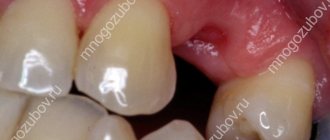Tooth extraction is not a pleasant process. Painful sensations and swelling of the gums after extraction of a tooth are an adequate response of the body to the operation. Usually, unpleasant symptoms increase 3-4 hours after the effect of the anesthetic drug wears off. Normally, pain, swelling, redness of the mucous membrane after a conventional extraction are observed for another 2-3 days; after a complex extraction, symptoms persist for 3-5 days. If your gums hurt after tooth extraction after 7 days or longer, you need a medical examination.
Why does my gum hurt?
Unexpressed aching pain and slight swelling of the gums appear due to injuries to soft tissues, nerves, and jaw bone when removing a tooth from its bed. The gum tissue swells, the nerve endings are compressed, hence the pain. How much your gums hurt after tooth extraction depends on:
- Patient's pain sensitivity;
- degree of complexity of the intervention;
- features of the clinical case;
- location of the dental unit (after extraction of molars, the injury is greater, the pain lasts longer);
- state of immunity.
The body’s normal response from the development of complications is distinguished by the following properties: the pain does not intensify, pathological symptoms are present for no more than 7 days, and no other signs of deterioration in well-being are observed.
How to speed up the healing process of the hole?
The process of tissue regeneration will be as comfortable and painless as possible if you follow the following instructions:
- do not injure the blood clot;
- do not eat for 3-6 hours after tooth extraction;
- exclude hard, spicy, sweet and hot foods from the diet for several days;
- avoid physical exertion, hypothermia and overheating for 3 days after removal;
- use a toothbrush with softer bristles;
- give up smoking and alcohol for a couple of days;
- Follow your dentist’s recommendations for taking anti-inflammatory and pain medications.
How long does your gum hurt after tooth extraction?
Normally, after 1-3 days, tissue swelling gradually decreases, pain goes away, and health improves. Already on the 3-4th day, the blood clot is gradually replaced by granulate, and after a week it fills the entire hole. After tooth extraction in the upper jaw, the recovery time is identical to the lower jaw, but bone regeneration in the upper dentition occurs more slowly.
In some clinical cases, the surgeon may cut the gum and drill out the jaw bone. Typically, such manipulations accompany the extraction of the outer eighth molars (wisdom teeth). Then healing takes longer than after a simple operation.
If 5-7 days after the intervention the pain does not decrease, but rather becomes more intense, you should consult a doctor. Acute, nagging, constant pain after tooth extraction can be a symptom of complications.
The tooth socket heals in approximately 2-4 weeks. Recovery time depends on the parameters of the wound and the body’s reaction to the removal procedure. Bone volume is restored approximately 6 months after the intervention.
Prevention of complications
Normally, immediately after tooth extraction, there should be a red blood clot in the socket. On the second day, this clot becomes covered with a whitish or yellowish coating, and after a week, a new gum begins to appear at the site of removal.
In order for the gum healing process to proceed as quickly and painlessly as possible, you should adhere to the following general recommendations:
- We keep it cold for the first day. Freeze a bottle of water, wrap it in a towel and hold it in the removal area for 10-15 minutes, applying it to the cheek. Breaks are 10-15 minutes. Cold prevents swelling and is a good pain reliever.
- In the first three days, diet. We exclude hard foods, fibrous foods (cabbage, meat), hot foods and drinks.
- On the first day, we exclude physical activity (weight lifting, gym, etc.). The load leads to an increase in pressure, and due to the increased pressure, a blood clot can be washed out of the socket.
- We do not rinse our mouths on the first day. From the second day we make baths with antiseptics (we put the solution in our mouth, tilt our head to the side where it was removed, hold it for a minute, spit it out).
- The day before removal and the first three days after, you can take antihistamines (loratadine, tavegil and others). In addition to the antiallergic effect, they also have a pronounced anti-edematous effect.
- If it hurts a lot, we take painkillers. Nimesil, solpadeine, ibuprofen, ketanov or other drugs (as recommended by your doctor). It is better to choose one drug and not mix it with others.
All other measures (antibiotics, physiotherapy, etc.) are only as prescribed by your doctor.
What happens if you ignore pathological pain
The appearance of pain always signals a problem in the body. If the tooth was removed long ago, and the pain persists or increases, this is evidence of a complication. Pain may be associated with:
- Increased body temperature;
- severe swelling, redness of the mucous membrane;
- halitosis;
- purulent discharge from the socket;
- white or gray coating on the mucous membrane;
- enlargement of the submandibular lymph nodes;
- pain while swallowing;
- restriction when opening the mouth.
In this situation, you should see a doctor immediately.
Ignoring alarming symptoms is fraught with serious problems, such as abscess and osteomyelitis. These are serious pathologies that require timely, qualified treatment.
Tumor as a sign of complications
The most common cause of deterioration occurs due to improper care of the formed hole. If the clot is broken and an infection has entered, then this can lead to swelling of the cheeks and gums, so you should definitely make an appointment with the dentist so that he can quickly solve this problem. You should consult a doctor if:
- constantly increasing throbbing pain;
- temperature is above 38 and does not go away for several days;
- when the jaw moves, the pain intensifies;
- The tumor is constantly growing and there is swelling.
At the appointment, the doctor will clean the hole and treat it with an antiseptic. In some cases, repeat surgery and antibiotic therapy may be required.
How to get rid of pain at home
To eliminate postoperative pain, the dentist will prescribe analgesics and cold compresses on the side of the intervention. Additionally, you can use traditional methods - mouth baths made from tinctures or herbal decoctions. Baths with an antiseptic drug are also allowed (the solution must be held in the mouth for a while and spat out). What is strictly forbidden:
- warm the operated area;
- rinse your mouth intensively (you can wash out the blood clot);
- chew on the injured side;
- “check” the hole using your tongue, fingers, and apply medicine to it.
The risk of complications depends on the complexity of the operation to remove a dental unit. Simple extraction is carried out if the tooth does not have strong, intertwined roots, it is intact, and there are no associated problems (cysts, pulpitis, periodontitis, etc.).
Extraction of dystopic teeth, which are very crooked, have intertwined, crooked roots, with a destroyed coronal part, and with an inflammatory process, is considered difficult. In such cases, a more extensive operation may be necessary with a preliminary incision in the gum, sawing the tooth into elements, extracting fragments through a hole in the jaw bone, and applying sutures. Molars are usually difficult to remove. If your gums hurt for several days after the removal of a molar, but the painful symptoms are smoothed out, then the wound is healing normally.
Pain in the tooth socket after extraction
If the tooth extraction operation is adequately carried out and all the dentist’s recommendations are followed, then after a couple of days the tooth socket should heal painlessly. A plaque forms at the site of damage, which is gradually covered by epithelial tissue as new bone tissue begins to grow.
And if pain persists after these days, it means that due to a combination of circumstances, inflammation has begun in the injured area (alveolus). In medical terminology, this process is called post-extraction alveolitis or alveolitis of the socket.
Etiology of alveolitis
After the tooth is removed, the created cavity should be filled with blood, which after a short time will transform into a special blood clot. Such a clot forms a biological barrier against all kinds of mechanical damage and infection.
But in some cases, the integrity of the blood clot is disrupted or for some reason it is completely absent, then the healing process is disrupted. In this regard, the development of alveolitis of the socket begins, which appears already on the third day and is accompanied by pain.
The main reasons for its occurrence and development are considered to be:
- Incorrectly performed surgery with violations of antiseptic rules, involuntary involvement of dental plaque in the socket, etc.
- Insufficient treatment of the postoperative socket, as a result of which small particles of tooth or pathological tissue remain in it.
- Complexity of the operation.
- Insufficient or complete absence of outpatient procedures for oral care recommended by a doctor.
- Failure to comply with simple hygiene standards.
- Eating food (especially spicy, hot or rough) before the recommended time.
- Self-medication by rinsing on the day of removal.
- Smoking in the first hours after tooth loss.
- Weak immune defense of the body.
- A number of common diseases that can affect the development of the inflammatory process.
Post-extraction alveolitis is dangerous due to severe consequences and complications. Therefore, this procedure must be approached responsibly and trusted to experienced and adequate specialists.
Symptoms and their manifestation
Usually, with a “dry” socket (no blood clot), the inflammatory process begins quite quickly after removal. Residues of food and saliva may be observed in an unprotected formation. Redness of the nearby gums is noticed, touching which causes pain.
If you do not seek medical help in time, the symptoms become more noticeable and are accompanied by:
- not soothing, rather severe pain in the damaged area;
- general condition worsens with rising temperature;
- a feeling of pain spreading throughout the entire jaw;
- the appearance of pus in the wound, resulting in a purulent odor from the mouth;
- formation of black plaque on the gum and socket;
- The submandibular lymph nodes gradually enlarge.
Emergency treatment at home
If the first signs of alveolitis appear and you cannot see a doctor within two to three days, you can try to alleviate the symptoms of the disease yourself.
It is important to remember that not all methods, drugs or folk remedies can cause relief. Some may even make the condition worse. For example, such well-known antiseptics as hydrogen peroxide or soda, on the contrary, will clean the infected hole beyond recognition, freeing it from blood clots, so that it will remain completely defenseless for infections.
If you can contact a specialist, you can use some types of analgesics to relieve pain. These include Baralgin, Ketanov or something similar. To relieve inflammation, you can rinse with a weak solution of potassium permanganate or furatsilin.
But natural antiseptics can be the most effective at home. Consider some folk recipes that have worked well for this disease.
Remedy No. 1
The herbal mixture has a good effect. Flax seed, blessed knycus, creeping tenacious (grass), blue cornflower (flowers), oregano, sunflower petals, are crushed and mixed in equal proportions. Then a spoon (tablespoon) of the crushed collection is filled with one glass of boiling water. The hour is running out. The strained mixture is divided into 4 doses and drunk throughout the day. Good reviews when using this decoction in the form of inhalation.
Remedy No. 2
Pour two tablespoons of St. John's wort (herb) and a spoonful of chamomile (flowers) into half a liter of boiling water and leave covered for two hours. Strain the resulting mixture and rinse your mouth with it at least every hour.
Remedy No. 3
A spoonful of medicinal sage is poured into a glass of boiling water. Brew for an hour in a thermos or wrapped in a thick thick cloth. After straining, rinse your mouth as often as possible throughout the day.
Remedy No. 4
A spoonful of dried chamomile flowers is poured into a glass of boiling water and steamed in a thermos for half an hour. Carefully filter and use as a rinse throughout the day.
Remedy No. 5
A decoction made from calendula (flowers) has an effective effect. A spoonful of flowers is poured with 200 ml of boiling water and steamed for half an hour. Then strain and rinse all day.
Of course, traditional methods of treatment can be effective, but it is better not to do without consulting specialists.











